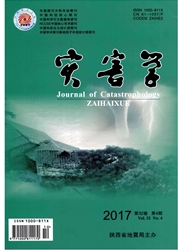

 中文摘要:
中文摘要:
四川省是我国泥石流灾害最严重的省份之一,掌握其灾害分布规律是有效开展灾害防治的基础。为此,根据1990-2007年四川省619起泥石流灾害数据和152个气象站的降水资料,统计分析了泥石流灾害的时空分布规律和降水特征。结果显示四川省泥石流灾害空间覆盖范围广,泥石流高发区主要分布在安宁河断裂带和龙门山断裂带周围;灾害主要发生在6-8月,其年际分布和年内分布均与暴雨雨量显著相关,且具有夜发性特点;大部分灾害发生时所在县级行政单元气象站所测雨量未达到大雨水平,群发性泥石流发生的当日雨量大于非群发性泥石流。此外,提出了现有雨量站网布设密度不能满足泥石流预报需求的问题。
 英文摘要:
英文摘要:
Sichuan Province is one of the regions in China where debris flow hazards are significantly serious. In this study,619 debris flow events which occurred during 1990-2007 in this region were employed to analyze the spatial and temporal distribution of debris flows. It suggests that more than half of the counties have been threatened by debris flows,with counties of high debris-flow incidence generally located along the Longmenshan fault or Anninghe fault. In addition,torrential rain plays an important role in the temporal distribution of debris flows,and most debris flows occurred between June and August,with the incidence during the nighttime higher than that during the daytime. Furthermore,precipitation data measured by 152 meteorological stations were utilized to investigate the characteristics of rainfalls that triggered these debris flows. It indicates that debris-flow triggering rainfalls are below 25 mm/day in most cases,and rainfalls that triggered a group of debris flow events are generally greater than those which triggered a single debris flow event. Moreover,this study reveals that the present rain gauge network is too sparse for debris flow forecast.
 同期刊论文项目
同期刊论文项目
 同项目期刊论文
同项目期刊论文
 期刊信息
期刊信息
